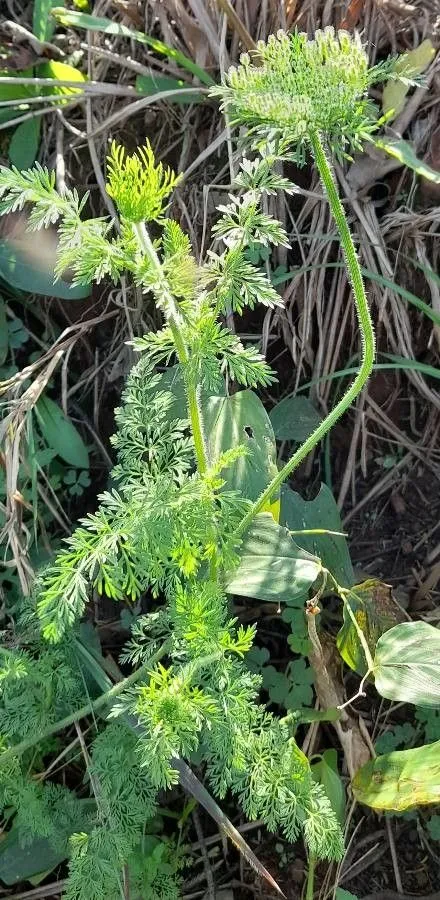
Author: Michx.
Bibliography: Fl. Bor.-Amer. 1: 164 (1803)
Year: 1803
Status: accepted
Rank: species
Genus: Daucus
Vegetable: False
Observations: SW. Canada to N. Mexico (and Guadalupe), Brazil to S. South America
Rattlesnake-weed, scientifically known as Daucus pusillus, is a species belonging to the Apiaceae family. It was first described by the renowned botanist Michx. in the early 19th century, as documented in Flora Boreali-Americana in the year 1803. This plant is notable for its widespread distribution, stretching from southwestern Canada to northern Mexico, encompassing even Guadalupe Island. Beyond North America, Daucus pusillus can also be found ranging from Brazil to the southern regions of South America.
Rattlesnake-weed is distinguished by its characteristic appearance, which closely resembles that of its more well-known relative, the cultivated carrot, but on a generally smaller scale. The plant features delicate, finely dissected leaves and produces clusters of tiny white or pinkish flowers arranged in umbels. These floral structures are efficient in attracting pollinators, ensuring the successful reproduction of the species.
The habitat of Daucus pusillus is notably diverse. It thrives in a variety of soil types and conditions, which contributes to its extensive geographic distribution. The adaptability of this plant allows it to colonize regions from temperate climates in Canada to the more arid and tropical areas of South America.
In addition to its botanical interest, Rattlesnake-weed holds cultural significance in various indigenous and local communities where it occurs. The plant has been traditionally noted for its potential medicinal uses, although modern documentation and studies on its efficacy remain limited.
Daucus pusillus is a fascinating example of the intricate interplay between plant species and their environments. Its broad distribution and adaptability make it a subject of interest for botanists and ecologists alike, providing insights into the evolutionary pathways and survival strategies of wild carrot species.
Whether encountering Daucus pusillus in the picturesque landscapes of southwestern Canada or the rugged terrains of South America’s southernmost regions, this plant stands as a testament to nature’s incredible diversity and resilience.
Eng: american wild carrot, southwest wild carrot, rattlesnake carrot, rattlesnake weed, rattlesnake-weed, rattle-snake weed, rattle-snake-weed, southwestern carrot
Por: cenoura-selvagem
Fra: carotte naine
En: Rattlesnake-weed, American wild carrot, SOUTHWEST WILD CARROT, Rattlesnake carrot, Rattlesnake weed, Rattle-snake weed, Rattle-snake-weed, Southwestern carrot
Ar: جزر دقيق
Fr: Carotte naine
Pt: Cenoura-selvagem
© copyright of the Board of Trustees of the Royal Botanic Gardens, Kew.
Taken Jul 11, 2020 by jason wiza (cc-by-sa)
Taken Aug 1, 2020 by Lauraine Garten (cc-by-sa)
Taken Aug 11, 2021 by Don Whittemore (cc-by-sa)
Taken May 23, 2019 by Stephenie Martin (cc-by-sa)
Taken Jul 25, 2021 by Trap Hers (cc-by-sa)
Taken May 6, 2015 by EOL − Lew Stringer (cc-by-nc)
Taken Jun 4, 2014 by EOL − boschniakia (cc-by-nc)
Taken Jun 7, 2006 by EOL − Steve Matson (cc-by-nc)
Taken Mar 24, 2012 by EOL − Michael J. Gras, M.Ed. (cc-by)
Taken Jul 25, 2021 by Trap Hers (cc-by-sa)
Taken Apr 10, 2022 by Maarten Vanhove (cc-by-sa)
Taken Jun 2, 2020 by Cynthia Brinkley (cc-by-sa)
Taken Jul 25, 2021 by Trap Hers (cc-by-sa)
Taken Dec 18, 2021 by William Coville (cc-by-sa)
Taken May 19, 2019 by Francesco Parenti (cc-by-sa)
Taken Apr 13, 2022 by Joseph (cc-by-sa)
Taken Aug 2, 2022 by Гаст Арбайтер (cc-by-sa)
Taken Apr 24, 2005 by EOL − Robert Sivinski (cc-by-nc)
Taken Jun 14, 2015 by EOL − Linda Jo Conn (cc-by-nc)
Taken Oct 7, 2015 by EOL − dshell (cc-by-nc)
Taken Dec 6, 2015 by EOL − Bob O’Kennon (cc-by-nc)
Taken Jun 14, 2015 by EOL − Linda Jo Conn (cc-by-nc)
Growth habit>: Forb/herb
Family: Myrtaceae Author: (F.Muell.) K.D.Hill & L.A.S.Johnson Bibliography: Telopea 6: 402 (1995) Year: 1995 Status:…
Family: Rubiaceae Author: Pierre ex A.Froehner Bibliography: Notizbl. Bot. Gart. Berlin-Dahlem 1: 237 (1897) Year:…
Family: Sapindaceae Author: Koidz. Bibliography: J. Coll. Sci. Imp. Univ. Tokyo 32(1): 38 (1911) Year:…
Family: Asteraceae Author: A.Gray Bibliography: Pacif. Railr. Rep.: 107 (1857) Year: 1857 Status: accepted Rank:…
Family: Fabaceae Author: Medik. Bibliography: Vorles. Churpfälz. Phys.-Ökon. Ges. 2: 398 (1787) Year: 1787 Status:…
Family: Aspleniaceae Author: (Cav.) Alston Bibliography: Bull. Misc. Inform. Kew 1932: 309 (1932) Year: 1932…